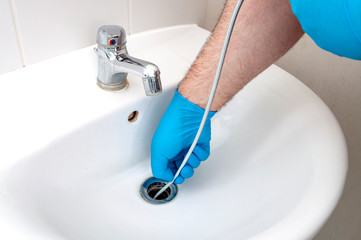Every day grease, hair, soap scum, and food particles make their way down your drain pipes. If left unchecked, this can lead to a severe clog or pipe failure.
Having your drains professionally cleaned can save you money in the long run. It also saves you from having to repair water damage in your home. Contact Drain Cleaning Los Angeles for professional assistance.
Typically, clogs form when organic debris like food scraps, skin cells, hair, soap scum, and dirt build up inside your drain pipes. This is made worse by hard water that corrodes metal pipe walls over time. Clogged pipes can lead to unpleasant odors and prevent proper functioning of your home’s plumbing fixtures. Fortunately, there are ways to keep your home’s drain lines clean and working correctly.
Regularly cleaning your drain lines with a drain maintainer is one of the most effective strategies to avoid clogs and backups. These products are non-caustic and usually comprise of bacteria that consume organic waste and convert it to water and CO2. They can be used as preventative maintenance or to break up existing clogs. However, these products are not as effective at removing clogs as a caustic drain cleaner or a drain auger.
If your clogged pipes are causing foul smells or are making gurgling and sucking sounds when you turn on the sink or toilet, it is likely time for professional drain cleaning services. Professional plumbers can use a variety of tools to remove even the most stubborn clogs without damaging your pipes or plumbing fixtures.
For example, a plumber may suggest hydro jetting, which involves using a powerful water hose to blast away hard clogs and residue. The high water pressure of this method scoures away debris and completely cleans the interior of your drain pipes, preventing future blockages.
There are three types of chemical drain cleaners, each with its own unique application: Caustic drain cleaners contain lye and work by giving off electrons to the clog material to generate heat, which melts the grease. Oxidizing drain cleaners are more acidic than caustic cleaners and dissolve organic material such as hair and grease. They are more suitable for kitchen sinks and grease traps. Acidic drain cleaners, which contain sulphuric or hydrochloric acid ingredients, are the harshest type of cleaner and should be reserved for worst-case scenarios because they can be harmful to your plumbing system and health.
Other common methods for removing clogs include plungers, drain augers and hydro jets. Most of these methods are more effective than liquid drain cleaners but they can also damage your pipes if misused.
Clogged Sinks
A sink drain can become clogged with food particles, hair, soap scum, and more. The resulting smell can be unpleasant and may spread throughout your home if the clog is bad enough. Fortunately, there are a few simple kitchen chemistry solutions that can often dissolve a sink clog.
Start by pouring one cup of baking soda into the drain followed by one cup of vinegar. Allow the mixture to fizzle and sit for about 15 minutes. Then, slowly pour boiling water down the drain. Repeat if necessary until the clog is removed.
If a sink drain is still clogged, try using a plastic drain snake that is specifically designed for sinks. These 24-inch to 36-inch long strips are flexible and have a series of barbs that can grab onto clogs and pull them out the way they went in. These tools typically cost less than $20, and they can be reused many times over the years.
Stubborn clogs may require the use of harsher chemicals, but be careful when using them. These cleaners can cause chemical and thermal burns to your skin if they come into contact with it. Remove the sink stopper and any standing water from the sink (either by bailing it out or by using a wet/dry shop vac) before pouring in the drain cleaner. Follow the product’s instructions for proper usage, and flush the drain with hot water afterward to prevent a bad smell.
To avoid future clogs, put in place drain strainers that catch food particles and other debris before they enter your pipes. Be sure to empty these traps on a regular basis. Also, don’t pour grease or oil down your drains because they can harden and cling to the inside of your pipes. Pouring a liter of hot water down your sink once a week can help dissolve and wash away any food particles that could otherwise clog your drains.
For stubborn clogs that aren’t easily solved with kitchen chemistry, you can try an electric drain snake or a plunger. These heavy-duty cables have a motor that rotates a blade fastened to the end of the cable, breaking apart clog particles.
Clogged Toilets
If you find yourself dealing with a constantly clogged toilet, it may be time to consider calling in professional drain cleaning services. Every toilet, sink, tub and washing machine in your home has a drain line that leads to your sewer line. This line carries waste away to your municipal sewage removal lines or septic system. Clogs in this line can be extremely serious and could cause your entire plumbing system to stop working.
Many toilet clogs are caused by non-flushable items that make their way into the commode’s drain pipe. This includes sanitary items, paper towels, cotton balls and swabs, and other items that don’t dissolve like toilet tissue. Educating your family members about what can and cannot be flushed can help prevent these types of clogs from occurring. Keeping small trashcans in your bathroom can also be helpful for storing items that don’t belong in the toilet.
When a clog occurs, try plunging the toilet to break up a clump of debris and open the drain. If this doesn’t work, you can attempt to dislodge the clog using a plumber’s snake. This is a long metal stick that can poke into the clog and break up tougher materials.
If you don’t have a plunger or a drain snake, you can try filling a bucket with hot water (not boiling water to avoid cracking the porcelain of the toilet) and pouring it down the toilet. This can force water into the clogged area and push it through the toilet trap.
Another thing that can cause a constant clog in your toilet is a blocked-up toilet vent. The vents are built into toilets to allow fresh air into the system, helping to build up pressure for strong, clog-preventing flushes. It’s important to keep them clean by removing any leaves, grass or other debris that may be blocking the vent.
If you’ve tried everything else and your toilet still isn’t clearing, you might want to call a professional for a drain auger service. This tool can be inserted into the toilet and will rotate and break up even the toughest clogs, allowing the drain to flow freely.
Clogged Showers
Nothing is more frustrating than getting ready to take a shower or bath, then realizing the water is draining slower than usual, or not at all. The good news is, there are a few troubleshooting steps you can try before calling in the plumber.
Baking soda and vinegar are a classic home cleaning combination that can be used to address clogs in the shower drain. Simply pour a cup of baking soda down the drain, then follow it with a cup of vinegar. The fizzing action helps break down hair, soap scum, and other debris that can build up in the shower drain. This is a great non-toxic, eco-friendly, and inexpensive option for clearing your drain, especially since you likely already have these ingredients on hand.
Another common and easy to use shower drain cleaning technique is to pour boiling water down the drain. Boiling water quickly heats up and dissolves grease and soap scum that is typically the cause of a clogged shower. This method is most effective on small clogs, so it may not be enough to tackle larger blockages. However, it can be used in conjunction with other methods listed here to help clear your drain.
Lastly, you can also try using a store bought drain snake or auger to break up and remove a clog. These snake-like devices have a claw on the end that can be pushed down the drain to grab and pull out hair and other debris. Using this tool in combination with other techniques can help to eliminate even the most stubborn shower clogs without having to use harsh chemicals.
If none of these troubleshooting techniques work to clear your clogged shower drain, you can always call in the professionals for professional drain cleaning services. A professional plumber can use cutting-edge equipment to safely and rapidly clean your shower drain, restoring it to full functionality and preventing future clogs.


 It’s a broad category of digital healthcare services that includes synchronous and asynchronous real-time interactions and remote patient monitoring. It also covers a variety of specialties like dermatology and psychotherapy.
It’s a broad category of digital healthcare services that includes synchronous and asynchronous real-time interactions and remote patient monitoring. It also covers a variety of specialties like dermatology and psychotherapy.